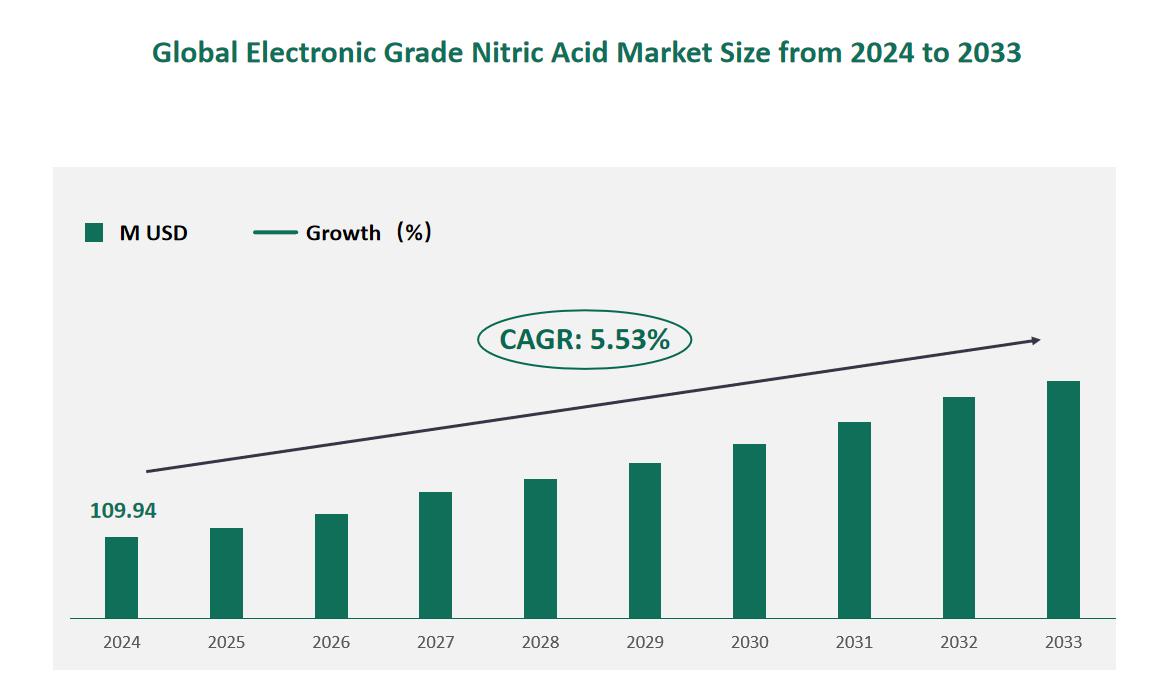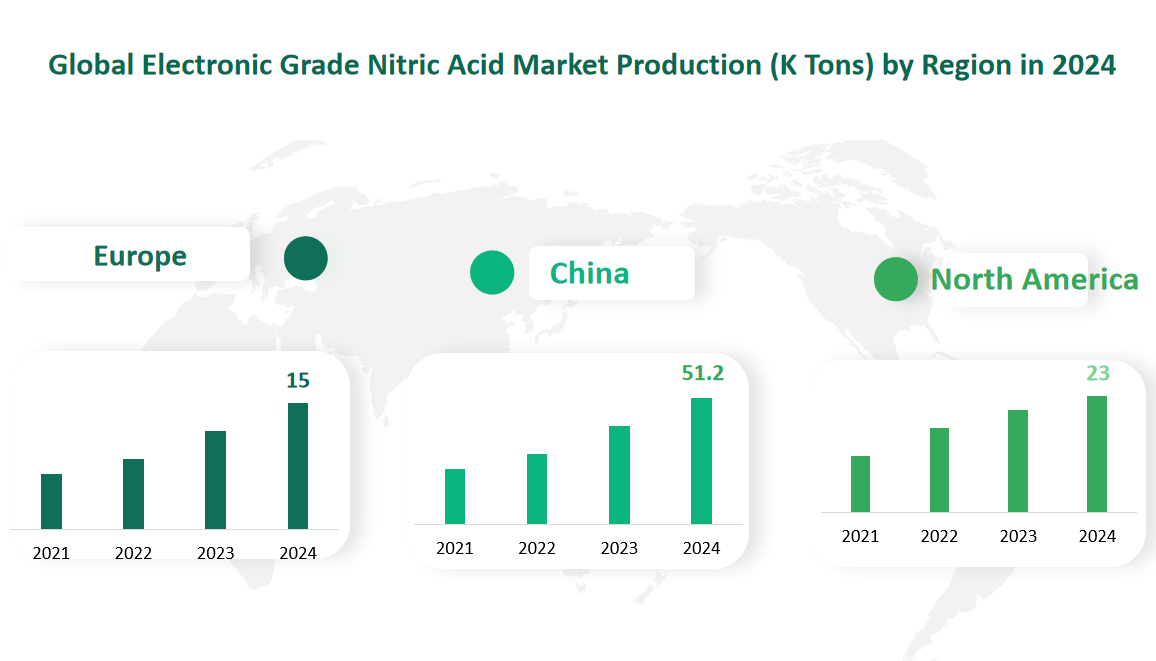1 Global Electronic Grade Nitric Acid Market Size (Value) and CAGR (2024-2033)
In 2024, the global Electronic Grade Nitric Acid market was valued at USD 109.94 million, with a CAGR of 5.53% from 2024 to 2033.
Nitric acid is poisonous liquid that gives off choking red or yellow fumes in moist air. It is a strong oxidizing agent. It ionizes readily in solution, forming a good conductor of electricity. It is miscible with water in all proportions. Nitric acid is a clear to slightly yellow aqueous solution that has been treated to remove most free nitrogen oxides. This report only focuses on Electronic Grade Nitric Acid.
Figure Global Electronic Grade Nitric Acid Market Size (M USD) and CAGR 2024-2033

2 Electronic Grade Nitric Acid Market Drivers
The market for Electronic Grade Nitric Acid (EGNA) is driven by several key factors that are fueling its growth and expansion. One of the primary drivers is the increasing demand for high-purity chemicals in the semiconductor industry. Semiconductors are the backbone of modern electronics, and EGNA is essential for cleaning and etching processes, ensuring the high quality and performance of these devices. As the global demand for electronic products such as smartphones, computers, and other consumer electronics continues to rise, the need for EGNA also increases.
Another significant driver is the rapid growth of the solar energy sector. Solar panels require high-purity chemicals for their manufacturing processes, and EGNA plays a crucial role in cleaning and etching silicon wafers. The increasing adoption of solar energy as a renewable and sustainable energy source is driving the demand for EGNA. Governments around the world are promoting renewable energy initiatives, which further supports the growth of the solar industry and, consequently, the EGNA market.
The LCD panel industry is also a major consumer of EGNA. With the continuous expansion of the display technology market, driven by the demand for larger and higher-resolution screens, the need for EGNA in the production of LCD panels is also growing. EGNA is used in the formation of nitride thin films and the etching of silicon dioxide, which are critical processes in LCD panel manufacturing.
3 Electronic Grade Nitric Acid Market Restraints
While the market for Electronic Grade Nitric Acid (EGNA) is experiencing growth, it also faces several challenges that could impact its development. One of the primary challenges is the stringent environmental regulations governing the production and use of nitric acid. EGNA production involves chemical processes that can generate waste and emissions, and companies must comply with increasingly strict environmental standards. The cost of implementing advanced pollution control technologies and managing waste can be significant, which may affect the profitability of EGNA manufacturers.
Another challenge is the fluctuation in raw material prices. The primary raw material for EGNA is nitric acid, and its price can be volatile due to changes in global supply and demand, as well as fluctuations in the prices of related commodities such as crude oil and natural gas. These price variations can impact the cost of production for EGNA, making it difficult for manufacturers to maintain stable pricing and profitability.
4 Global Electronic Grade Nitric Acid Market Size and Share by Type in 2024
EL Grade EGNA is the highest purity level, with a minimum purity of 99% and water content levels below 0.025 ppm. This grade is primarily used in semiconductor manufacturing due to its exceptional purity, which ensures high-quality and reliable performance in electronic devices. In 2024, the market value of EL Grade EGNA is estimated at 37.83 million USD. This segment is crucial for the semiconductor industry, where even the slightest impurities can significantly impact the functionality and reliability of chips and other components.
VL Grade EGNA has a purity level between 99% and 98%, with water content levels below 0.01 ppm. This grade is used in various applications, including pharmaceuticals and other industries where high purity is required but not as stringent as EL Grade. In 2024, the market value of VL Grade EGNA is projected to be 27.17 million USD. This segment benefits from its versatility and lower cost compared to EL Grade, making it suitable for a broader range of applications.
UL Grade EGNA is characterized by a minimum purity of 99.95% and impurities below 0.05%. This grade is used in semiconductor processes that require extremely low levels of contaminants to ensure the highest quality of products. In 2024, the market value of UL Grade EGNA is estimated at 23.85 million USD. This segment is critical for advanced semiconductor manufacturing, where the removal of even trace amounts of impurities is essential for the performance and reliability of electronic components.
SL Grade EGNA contains 72% to 78% pure HNO₃ and is used in applications such as LCD panels, glass etching, and silicon wafer cleaning. This grade is particularly important for the display technology industry, where it helps in the formation of nitride thin films and the etching of silicon dioxide. In 2024, the market value of SL Grade EGNA is projected to be 21.09 million USD. This segment is driven by the growing demand for high-resolution displays and advanced display technologies.
Table Global Electronic Grade Nitric Acid Market Size and Share by Type in 2024
Type | Market Size (M USD) 2024 | Market Share 2024 |
EL Grade | 37.83 | 34.41% |
VL Grade | 27.17 | 24.72% |
UL Grade | 23.85 | 21.69% |
SL Grade | 21.09 | 19.19% |
5 Global Electronic Grade Nitric Acid Market Consumption and Share by Application in 2024
The semiconductor industry is the largest consumer of EGNA, driven by the increasing demand for high-purity chemicals in the manufacturing of integrated circuits and other semiconductor devices. In 2024, the consumption of EGNA in the semiconductor industry is estimated at 64.1 K Tons, accounting for 41.75% of the total market. This segment is critical as EGNA is used for cleaning and etching processes, ensuring the high quality and performance of semiconductor products.
The solar energy sector is another significant consumer of EGNA, particularly in the production of solar panels. EGNA is used to clean and etch silicon wafers, enhancing their efficiency and performance. In 2024, the consumption of EGNA in the solar energy industry is projected to be 37.9 K Tons, representing 24.69% of the total market. The growth of the solar industry, driven by the increasing adoption of renewable energy, is a key factor in the demand for EGNA.
The LCD panel industry also relies heavily on EGNA for the production of high-quality displays. EGNA is used in the formation of nitride thin films and the etching of silicon dioxide, which are critical processes in LCD panel manufacturing. In 2024, the consumption of EGNA in the LCD panel industry is estimated at 34.6 K Tons, or 22.51% of the total market. The continuous expansion of the display technology market, driven by the demand for larger and higher-resolution screens, supports the growth of this segment.
Table Global Electronic Grade Nitric Acid Market Consumption (K Tons) and Share by Application in 2024
Application | Market Consumption (K Tons) 2024 | Market Share 2024 |
Semiconductor | 64.1 | 41.75% |
Solar Energy | 37.9 | 24.69% |
LCD Panel | 34.6 | 22.51% |
Others | 17.0 | 11.05% |
6 Global Electronic Grade Nitric Acid Market Production by Region in 2024
North America is a significant producer of EGNA, with a focus on high-purity chemicals for the electronics industry. In 2024, the production of EGNA in North America is estimated at 23.0 K Tons, accounting for 14.93% of the total market. The region benefits from advanced technology and a strong industrial base, supporting the production of high-quality EGNA.
Europe is another key region in the production of EGNA, driven by its strong chemical industry and demand from the electronics sector. In 2024, the production of EGNA in Europe is projected to be 15.0 K Tons, representing 9.75% of the total market. European producers are known for their high standards of quality and innovation, contributing to the global supply of EGNA.
China is a major player in the EGNA market, with significant production capacity and a growing demand from its electronics industry. In 2024, the production of EGNA in China is estimated at 51.2 K Tons, accounting for 33.19% of the total market. China’s rapid industrialization and technological advancements have positioned it as a leading producer and consumer of EGNA.
Figure Global Electronic Grade Nitric Acid Market Production by Region in 2024

7 Major Players in Global Electronic Grade Nitric Acid Market
7.1 Mitsubishi Chemical
Company Profile: Mitsubishi Chemical Corporation is a leading global chemical company headquartered in Tokyo, Japan. Established in 2005, it operates worldwide and offers a diverse range of products and services across various industries, including chemicals, performance products, health care products, and industrial materials.
Business Overview: Mitsubishi Chemical is renowned for its high-quality products and innovative solutions. The company’s business model focuses on providing ultra-high purity process chemicals for the semiconductor and flat panel display (FPD) industries. Its Star Series products are specifically designed to meet the stringent requirements of semiconductor manufacturing, ensuring minimal impurities and high performance.
Product Portfolio: Mitsubishi Chemical’s EGNA products are part of its Star Series, which includes ultra-high purity process chemicals. These products are characterized by their ability to remove particles, organic residues, and metal residues, ensuring high-quality semiconductor and FPD manufacturing processes. The company’s EGNA products are available in various grades, tailored to meet the specific needs of different applications.
Recent Financial Data: In the most recent year, Mitsubishi Chemical’s EGNA production was approximately 15.0 K Tons. The company’s revenue from EGNA sales was around 11.89 million USD, with a gross margin of 36.56%.
7.2 Kanto
Company Profile: Kanto Chemical Co., Ltd. is a prominent chemical manufacturer based in Tokyo, Japan. Established in 1944, Kanto has a long history of providing high-quality reagents and chemicals for various industries, including pharmaceuticals, life sciences, and electronics.
Business Overview: Kanto specializes in the production of high-purity chemicals, including EGNA, which is essential for the electronics industry. The company’s comprehensive reagent manufacturing capabilities and commitment to quality have made it a trusted supplier for semiconductor and FPD manufacturers worldwide.
Product Portfolio: Kanto’s EGNA product portfolio includes various grades of nitric acid, each tailored to meet the specific requirements of different applications. The company’s EGNA products are known for their high purity and reliability, making them suitable for critical processes in semiconductor manufacturing and other high-tech industries.
Recent Financial Data: In the most recent year, Kanto’s EGNA production was approximately 12.7 K Tons. The company’s revenue from EGNA sales was around 9.94 million USD, with a gross margin of 33.86%.
7.3 BASF
Company Profile: BASF SE is a global chemical company headquartered in Ludwigshafen, Germany. Established in 1865, BASF is one of the world’s largest chemical producers, offering a wide range of products and solutions across various industries, including chemicals, plastics, performance products, agricultural solutions, and oil and gas.
Business Overview: BASF’s business model focuses on providing innovative and sustainable solutions for its customers. The company operates in six segments, each targeting specific market needs. In the EGNA market, BASF is known for its high-purity nitric acid products, which are essential for the electronics industry. The company’s strong R&D capabilities and commitment to quality have positioned it as a leading supplier of high-purity chemicals.
Product Portfolio: BASF’s EGNA product portfolio includes various concentrations of nitric acid, tailored to meet the specific needs of different applications. The company’s products are known for their high purity and reliability, making them suitable for critical processes in semiconductor manufacturing and other high-tech industries.
Recent Financial Data: In the most recent year, BASF’s EGNA production was approximately 7.9 K Tons. The company’s revenue from EGNA sales was around 6.19 million USD, with a gross margin of 32.18%.

